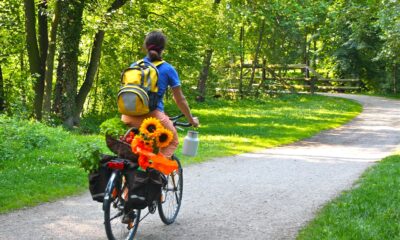

Editors Choice
How to Practice Sustainable Living in 2024
As we move into 2024, the urgency of addressing environmental issues has never been more apparent. Sustainable living is no longer a niche concept but a necessity for ensuring a healthier planet for future generations.
Practicing sustainable living involves making choices that minimize environmental impact and promote the responsible use of resources. This article explores practical strategies for adopting a sustainable lifestyle in 2024, offering actionable steps to help individuals and communities contribute to a more sustainable future.
1. Adopt Energy-Efficient Practices
A. Upgrade to Energy-Efficient Appliances
Energy-efficient appliances reduce energy consumption and lower utility bills. Look for products with the ENERGY STAR® label, which signifies that they meet strict energy efficiency criteria. Consider upgrading to energy-efficient models for:
- Heating and Cooling Systems: Install programmable thermostats and energy-efficient HVAC systems to optimize heating and cooling.
- Lighting: Replace incandescent bulbs with LED bulbs, which use less energy and last longer.
- Kitchen Appliances: Choose energy-efficient refrigerators, dishwashers, and ovens to reduce energy consumption.
B. Utilize Renewable Energy Sources
Investing in renewable energy sources can significantly reduce your carbon footprint. Options include:
- Solar Panels: Install solar panels on your home to generate clean, renewable energy from the sun. Many regions offer incentives and rebates for solar panel installations.
- Wind Turbines: If you live in a windy area, consider installing a small wind turbine to generate electricity.
- Green Energy Programs: If installing renewable energy systems isn’t feasible, enroll in green energy programs offered by your utility provider, which support renewable energy projects.
C. Implement Energy-Saving Habits
In addition to upgrading appliances, adopting daily habits can further reduce energy consumption:
- Turn Off Lights and Electronics: Switch off lights and unplug electronics when not in use.
- Optimize Heating and Cooling: Before adjusting your thermostat, regulate the temperature using fans, natural ventilation, and appropriate clothing.
- Seal Leaks: Insulate windows and doors to prevent heat loss and reduce heating needs.
2. Reduce, Reuse, and Recycle
A. Embrace Minimalism
Adopting a minimalist lifestyle involves reducing unnecessary possessions and focusing on quality over quantity. This practice helps:
- Decrease Waste: Fewer items mean less waste and a reduced need for new resources.
- Simplify Living: A minimalist approach can lead to a more organized and less cluttered living space.
B. Reuse and Upcycle
Instead of discarding items, explore ways to reuse and upcycle:
- Repurpose Items: Use old furniture or clothing in new ways, such as turning an old dresser into a bookshelf.
- DIY Projects: Engage in DIY projects to give new life to items that might otherwise be thrown away.
C. Recycle Properly
Ensure that you are recycling materials correctly to prevent contamination:
- Sort Waste: Separate recyclables such as paper, plastic, glass, and metal from general waste.
- Follow Local Guidelines: Adhere to your community’s recycling guidelines, as rules may vary by location.
- Reduce Single-Use Plastics: Avoid using single-use plastics by opting for reusable alternatives like water bottles, shopping bags, and containers.
3. Support Sustainable Agriculture and Food Systems
A. Choose Local and Seasonal Foods
Buying local and seasonal produce reduces the environmental impact associated with transportation and supports local farmers:
- Farmers’ Markets: Shop for fresh, locally grown produce at farmers’ markets.
- Community Supported Agriculture (CSA): Participate in CSA programs to receive seasonal produce directly from local farms.
B. Adopt a Plant-Based Diet
Reducing meat and dairy consumption can lower your carbon footprint and promote sustainability:
- Incorporate More Plant-Based Meals: Experiment with plant-based recipes and meat substitutes.
- Grow Your Food: Start a garden to grow vegetables, herbs, and fruits at home.
C. Reduce Food Waste
Minimizing food waste is crucial for sustainability:
- Plan Meals: Create meal plans and shopping lists to avoid purchasing excess food.
- Proper Storage: Store food properly to extend its shelf life and reduce spoilage.
- Composting: Compost food scraps and organic waste to create nutrient-rich soil for gardening.
4. Sustainable Transportation Choices
A. Opt for Public Transportation
Using public transportation reduces the number of vehicles on the road and lowers greenhouse gas emissions:
- Buses and Trains: Utilize buses, trains, and subways for daily commutes and longer trips.
- Carpooling: Share rides with others to reduce the number of individual vehicles.
B. Embrace Alternative Transportation
Consider eco-friendly alternative transportation methods:
- Cycling: Use bicycles for short trips and daily commutes to reduce car reliance.
- Walking: Opt for walking when possible, which is environmentally friendly and beneficial for your health.
C. Explore Electric Vehicles (EVs)
Electric vehicles offer a cleaner alternative to traditional gasoline-powered cars:
- Research EV Options: Explore different EV models and incentives for purchasing or leasing electric vehicles.
- Charging Infrastructure: Utilize charging stations and home charging options to support the use of EVs.
5. Conserve Water Resources
A. Implement Water-Saving Measures
Reducing water usage helps conserve this vital resource:
- Low-Flow Fixtures: To reduce water consumption, install low-flow showerheads, faucets, and toilets.
- Fix Leaks: Repair any leaks in faucets, pipes, or toilets to prevent water wastage.
B. Practice Water-Efficient Gardening
Use water-efficient practices in your garden to minimize water use:
- Xeriscaping: Choose drought-resistant plants and landscaping techniques that require minimal irrigation.
- Rainwater Harvesting: Collect rainwater in barrels for use in watering plants and gardens.
6. Promote Green Building Practices
A. Sustainable Home Design
If building or renovating a home, consider incorporating sustainable design principles:
- Energy-Efficient Insulation: Use high-quality insulation materials to improve energy efficiency.
- Sustainable Materials: Choose building materials that are environmentally friendly and sourced sustainably.
B. Smart Home Technology
Integrate smart home technology to optimize energy use:
- Smart Thermostats: Use smart thermostats to regulate heating and cooling based on your schedule and preferences.
- Home Automation: Implement home automation systems to control lighting, appliances, and energy use more efficiently.
7. Engage in Community and Advocacy Efforts
A. Support Local Environmental Initiatives
Participate in or support local environmental initiatives and organizations:
- Community Cleanups: Join community cleanup events to help reduce litter and pollution.
- Environmental Advocacy: Advocate for sustainable policies and practices within your community and beyond.
B. Educate and Inspire Others
Share your knowledge and experiences to inspire others to adopt sustainable practices:
- Social Media: Use social media platforms to raise awareness about sustainability and share tips.
- Workshops and Events: Organize or participate in workshops and events focused on sustainable living.
In addition to making sustainable lifestyle choices, it’s essential to be prepared for unexpected situations, such as car accidents. Accidents can significantly impact your life, and understanding how to navigate legal challenges is crucial for managing the aftermath effectively. Hiring a trustworthy Denver motor vehicle accident lawyer can ensure you receive the support and compensation you need while dealing with the complexities of legal and insurance matters.
Sustainable Living In 2024 Requires Expertise and Time
Practicing sustainable living in 2024 involves a multifaceted approach that includes adopting energy-efficient practices, reducing waste, supporting sustainable agriculture, and making eco-friendly transportation choices. By integrating these strategies into your daily life, you can contribute to a healthier planet and set an example for others. As we continue to face environmental challenges, every small step toward sustainability can have a significant impact. Embrace these practices to build a more sustainable future for yourself, your community, and future generations.


 Environment10 months ago
Environment10 months agoAre Polymer Banknotes: an Eco-Friendly Trend or a Groundswell?

 Environment12 months ago
Environment12 months agoEco-Friendly Home Improvements: Top 7 Upgrades for 2025

 Features9 months ago
Features9 months agoEco-Friendly Cryptocurrencies: Sustainable Investment Choices

 Features10 months ago
Features10 months agoEco-Friendly Crypto Traders Must Find the Right Exchange





























